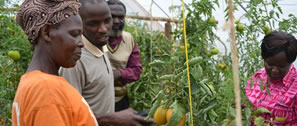Key facts: agriculture, environment and markets in eastern Africa

At least 65% of the population in eastern Africa works in agriculture (source: ILO). Growth in the agriculture sector is two to four times more effective in raising incomes among the poorest compared to other sectors (source: World Bank).
More than half of the world's extreme poor live in sub-Saharan Africa, that's almost 400 million people (source: World Bank). The vast majority live in rural areas and work in agriculture (source: FAO).
Africa is the youngest continent with 70% of the population in sub-Saharan Africa under the age of 30 (source: UN). With a rapidly growing population, job creation is a top priority. Africa's youth labour force has nearly doubled from 61.8 million in 1990 to 115.8 million in 2020, and is projected to increase by over 25 per cent by 2030 (source: ILO).
However, jobs in rural areas are often limited, particularly those that don't involve physical labour and meet the aspirations of young people, leading to rapid urbanisation.
Eastern Africa has fertile land and water resources available to invest in agriculture, however it also faces threats like soil erosion, deforestation and destruction of grazing lands.
Boosting agriculture in a sustainable way, while ensuring farmers have good access to markets are key to reducing poverty in Africa.
Discover the facts and figures behind our strategy:
Agriculture

- Agriculture employs 65% of the population in eastern Africa. (Source: ILO)
- Sub-Saharan Africa has a quarter of the world's arable land but only produces 10% of its agricultural output. (Source: IFAD)
- Smallholders manage 80% of the farmland in sub-Saharan Africa. (Source: FAO)
- Agriculture accounts for around 25% of total GDP in eastern Africa. (Source: Met Office Hadley Centre / ODI /UK aid)
- Growth in agriculture is two to four times more effective than any other sector in decreasing poverty. (Source: World Bank)
- Wasted food globally amounts to 1.3 billion tonnes per year, accounting for almost 30% of the world's agricultural land and 3.3 billions tonnes of CO2 per year. (Source: FAO)
- In 2021, nearly 828 million people were undernourished - almost one in 10 people worldwide. (Source: World Bank)
Environment

- Africa contributes only 3.6% of the total global emissions, but it is disproportionately affected by the impacts of climate change. (Source: ICPAC)
- A temperature rise of between 1.5°C-2°C will contribute to farmers losing 40% to 80% of cropland in the 2030s and 2040s. (Source: World Bank)
- Between 2000 and 2020, a total of 20.3 million hectares of tree cover were lost across DR Congo, Tanzania, Uganda, Ethiopia and Kenya - a land size almost equivalent to the whole of England and Scotland. (Source: Farm Africa strategy 2020-2025)
- Every year, the world loses 12 million hectares of productive land, leading to falling crop yields, massive food loss, conflict over natural resources and weakened resilience to climate change. (Source: United Nations)
- About 33% of the world soils are moderately to highly degraded. Forty percent of these soils are located in Africa. (Source: FAO)
Business

- Despite an abundance of uncultivated farmland, Africa is a net importer of food, spending $35 billion per year net on food imports. (Source: African Development Bank)
- Lack of finance prevents smallholders from buying the agricultural inputs they need to increase yields: smallholder farmers in Africa, Latin America and Asia face an estimated $180 billion funding gap.
- A Bank of Tanzania survey of 318 micro, small and medium-sized enterprises (MSMEs) in 2019 found that only 28% received loans. (Source: Farm Africa)
- Less than 20% of farmed land in Africa is cultivated with improved seed due to its lack of accessibility and affordability. (Source: Farm Africa)
- Many smallholder farmers have no formal links with buyers: just 7% of smallholder farmers worldwide have contracts with buyers. (Source: IIED)
- Intra-African trade currently accounts for 14.4% of the continent’s total trade. (Source: African Export-Import Bank)

